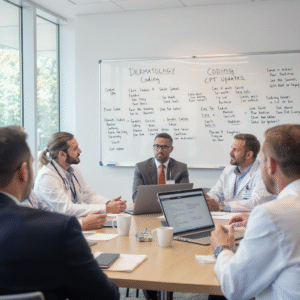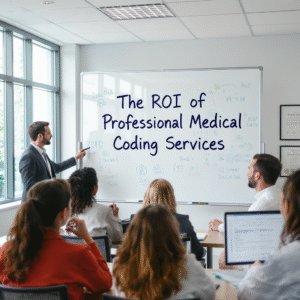The Link Between Staff Training and Claim Denial Rates: Why Investment in Education Pays Off
Claim Denial Rates
Claim Denial Rates
In the complex landscape of healthcare administration and insurance processing, one factor consistently emerges as a critical determinant of success: staff training. The relationship between comprehensive employee education and claim denial rates isn’t just correlational—it’s causational, with well-trained staff serving as the first line of defense against costly claim rejections.

Understanding the Cost of Claim Denials
Before diving into training solutions, it’s essential to grasp the true impact of claim denials. Industry studies show that the average cost to rework a denied claim ranges from $25 to $117 per claim, depending on complexity. For healthcare organizations processing thousands of claims monthly, these costs quickly compound into significant financial losses.
Beyond immediate financial impact, denied claims create ripple effects throughout the organization. They delay patient care, strain relationships with insurance providers, tie up administrative resources, and can damage an organization’s reputation for efficient billing practices.
The Training-Performance Connection
Research consistently demonstrates that organizations with robust training programs experience significantly lower claim denial rates. This connection manifests in several key areas:
Coding Accuracy and Compliance
Medical coding errors account for approximately 61% of claim denials. Staff members who receive regular training on current coding standards, including updates to ICD-10, CPT, and HCPCS codes, demonstrate markedly improved accuracy rates. Organizations that invest in continuous coding education report denial rate reductions of 15-30%.
Documentation Standards
Inadequate documentation is another leading cause of claim rejections. Training programs that emphasize proper documentation practices, including medical necessity requirements and supporting evidence protocols, directly correlate with improved claim acceptance rates. Staff who understand what constitutes sufficient documentation are far less likely to submit incomplete or inadequate claims.
Regulatory Knowledge
Healthcare regulations change frequently, and staying current requires dedicated effort. Staff training programs that include regular updates on regulatory changes, payer requirements, and compliance standards help prevent denials due to outdated practices or non-compliance issues.
Key Training Components for Denial Prevention
Effective training programs targeting claim denial reduction should include several core components:
Technical Skills Development
Staff need hands-on training with billing software, electronic health records systems, and claim submission platforms. Technical proficiency reduces errors stemming from system misuse or data entry mistakes. Regular software updates and feature training ensure staff can leverage all available tools for accurate claim preparation.
Communication and Collaboration Skills
Many claim issues arise from poor communication between departments. Training that emphasizes interdisciplinary collaboration helps create seamless workflows between clinical staff, coding specialists, and billing departments. When teams communicate effectively, critical information is less likely to be lost or misinterpreted.

Problem-Solving and Critical Thinking
Rather than simply following procedures, staff benefit from training that develops analytical skills. When employees understand the reasoning behind billing requirements, they’re better equipped to identify potential issues before claims are submitted and to resolve complex billing scenarios independently.
Measuring Training Effectiveness
Organizations serious about reducing claim denials must establish metrics to evaluate training program success. Key performance indicators include:
- First-pass claim acceptance rates: The percentage of claims accepted on initial submission
- Denial rate trends: Monthly tracking of denial rates by category and department
- Rework costs: Financial impact of denied claims requiring resubmission
- Staff confidence scores: Employee self-assessment of their billing and coding competency
- Time to resolution: How quickly denied claims are corrected and resubmitted
Building a Culture of Continuous Learning
The most successful organizations don’t treat training as a one-time event but rather as an ongoing cultural commitment. This involves creating learning pathways that include initial onboarding, regular refresher sessions, advanced skill development, and specialty training for complex cases.
Mentorship programs pair experienced staff with newcomers, creating knowledge transfer opportunities that benefit both parties. Regular team meetings that include educational components keep learning at the forefront of daily operations.
The Return on Investment
While training programs require upfront investment, the financial returns are substantial. Organizations that implement comprehensive training initiatives typically see:
- 20-40% reduction in claim denial rates within the first year
- Decreased administrative costs related to claim rework
- Improved cash flow through faster claim processing
- Enhanced staff satisfaction and retention
- Stronger relationships with insurance providers

Technology and Training Integration
Modern training programs leverage technology to enhance effectiveness. Learning management systems track individual progress and identify knowledge gaps. Simulation software allows staff to practice with realistic scenarios without risking actual claim submissions. Mobile learning platforms enable just-in-time training when staff encounter unfamiliar situations.
Overcoming Training Implementation Challenges
Common obstacles to effective training include time constraints, budget limitations, and staff resistance to change. Successful organizations address these challenges by:
- Integrating training into regular workflows rather than treating it as separate activity
- Demonstrating clear connections between training and job performance
- Providing multiple learning formats to accommodate different learning styles
- Recognizing and rewarding staff who actively participate in educational initiatives
Looking Forward: Future Training Trends
The healthcare industry continues evolving, with artificial intelligence, value-based care models, and changing regulatory requirements creating new training needs. Organizations that stay ahead of these trends by proactively updating their training programs will maintain competitive advantages in claim processing efficiency.

When Kendra Grant’s team was charged with designing and delivering learning experiences for 90,000 Walmart Canada associates, she knew as a senior learning-and-design director that the landscape of corporate learning needs was constantly changing. “Over time,” says Grant, now the principal of her own L&D practice, “we acknowledged that many of the problems we saw, such as lack of engagement and lack of retention, were a result of the design process and not the fault of the learners.”
If you are in a leadership role in your organization, you more than likely share this problem. Technology and society are driving changes faster than your people can adapt. According to the OECD, 1.1 billion jobs will be disrupted in the next five years. Employees the world over require upskilling (learning to improve current work) and reskilling (learning to do new types of work). Some organizations are heeding the signs and investing heavily in learning and development:
Walmart, for example, is investing $1 billion into reskilling its workforce, and McDonald’s has spent $165 million over the past eight years to prepare 72,000 employees for upward mobility. The Association for Talent Development’s most recent study found the average organization spends almost $1,300 per employee on professional learning. Microsoft’s CEO, Satya Nadella, exhorts everyone to be a “learn-it-all.”
Workers of today need to prepare for what they’ll be doing tomorrow. But how can they adapt effectively if their work is changing in real time? What skills can they learn now that will support them in the face of a volatile and ambiguous future? And how can their employers support them?
There’s a simple but not easy answer to all of these questions. Employers have to help employees become expert learners — people with the will to learn, the skill to do it effectively, and the ability to apply that learning in ways that positively impact their performance and that of their teams.
Still Wearing Blinders
Traditionally, learning within organizations has been driven by a single department. In a general attempt to motivate and support employee development, the learning-and-development team — which sometimes consists of just one person — acts as an order filler for operations managers and leadership, providing formal learning support, such as classroom training and online modules. Frequently, these efforts are augmented by tuition assistance for degree and certificate programs at institutes of higher education.
In recent years, companies have created digital “learning-management systems” or “learning-experience platforms” that offer a Netflix-style menu of learning content that employees can access on-demand and at their own pace.
Unfortunately, however, these approaches to employee learning are not up today’s challenge, for a few reasons:
A day late and a dollar short.
Content creation lags significantly behind the need for that content, making the content available less relevant to current needs. Also, when an employee needs new knowledge and skills now, a course next month isn’t helpful.
One-size-fits-none.
Every learner is unique, with varied strengths, experiences, and challenges. Every learner works in different contexts, thus requiring greater personalization to support meaningful learning and improvement.
A lack of support for application.
Pushing out content can impart new information, but developing effective skills requires coaching, reinforcement, and opportunities for safe, authentic practice.
A cultural disconnect.
Leaders can say they value learning, but according to Deloitte, workers actually have less than 1% of their time available for learning. Further, learning can be messy, because it requires that people try new things and make mistakes. If an organization punishes people for those mistakes, as some do, people will shy away from learning.
Learner experience and identity.
Not everyone thinks of themselves as a lifelong learner, nor do they all have the skills to learn and apply learning effectively. Further, biases in development programs may reinforce the notion that only some people are capable of learning and therefore worth the investment. This bias is communicated to workers.
There Is a Solution
We need to address these barriers to learning in order to meet the challenges of today and the future. Learning, after all, is what enables people to adapt to change and even become drivers of change. But, as Matthew Daniel has recently noted on the Chief Learning Officer website, even if people want to learn they may not know what to learn — or how to learn.
Expert learning requires two key conditions. The first is context. People need the time and space to learn. They need timely, actionable feedback; opportunities for collaboration; and just-in-time support to convert new knowledge and skills into measurable performance improvement.
Then there’s capacity. Each person has talents, strengths, interests, challenges, and experiences that influence how they engage with, make sense of, and apply new knowledge and skills. We can’t assume everyone has developed the requisite learning skills and behaviors, and we can’t effectively gauge learning capacity in advance. However, we can help all people become expert learners, by providing them with options to learn and apply key learning behaviors rooted in a framework known as the Universal Design for Learning.
UDL, as it’s often called, was first devised in the 1990s by researchers and clinicians at the nonprofit learning organization CAST, Inc., under the direction of the neuropsychologist David Rose, of the Harvard Graduate School of Education, and a co-founder, Anne Meyer. Today it’s endorsed in federal education legislation as a means for supporting inclusive, impactful learning for all learners. That includes workforce preparation and training.
In essence, UDL helps us embrace the differences between learners — their variability in strengths, interests, attitudes, cultures, and more — by setting firm, challenging goals and allowing for flexible pathways to meet those goals.
When employing UDL in creating learning experiences, you’re encouraged to think of learning as a set of behaviors and skills that exist on a continuum from novice to expert. Novice learning is primarily guided by external forces: Novices learn what they’re told, when they’re told, for the reasons given to them.
They are the type of learners whom top-down, one-size-fits-all training was meant to serve. A distinct step above the novice level is self-directed learning, where learners take the initiative for their own learning, making decisions about what, when, and how to learn.
Expert learning takes things to another level, by adding in specific learning skills and a focus on strategic performance improvement. Expert learners have the will and skill to learn, can identify ways to leverage that learning into impact, and are always looking for new challenges and ways to improve their skills. They are the learners best able to adapt to the rapidly changing modern workplace.
How Expert Learners Improve Outcomes
Building a strong learning culture that focuses on capacity and context can give companies a strategic advantage. Let’s consider why.
First, employees who are skilled learners can more readily innovate, for what is innovation if not the learning how to solve a problem in a new way? A person focused on continuous improvement rarely settles for “We’ve always done it this way.” Expert learners can identify emerging knowledge and skill needs and generate new knowledge to meet those needs.
Next, learning fuels employee engagement. Employer-supported learning is a key driver of retention, particularly when learning is visibly linked to employee development — that is, upward mobility. Creating a culture that supports people to learn and own their improvement makes improvement a common cause between the employees and the organization. Further, a visible emphasis on learning can be key to attracting new talent, with Gen Z and Millennial workers citing learning and upward mobility as key motivators in selecting job opportunities.
Finally, investing in learning is just that: an investment. According to Gallup, companies that invest in employee development increase profitability by 11%.
Building a Culture of Expert Learners
Building a culture of expert learning is a complex undertaking. There are, however, some foundational practices, aligned with UDL, that leaders and teams can engage in as they work to develop support an expert learning culture.
Adopt a learning philosophy and stick to it.
A learning philosophy is a codification of what the organization believes about learning, including its value, the responsibilities of each person related to learning, and the methods by which the organization will support its employees to learn and improve.
Consider the philosophy of the United States Marine Corps, where learning is literally a survival skill. In 2020, the USMC published Marine Corps Doctrinal Publication 7: Learning, or the MCDP 7, which tells all Marines, from the lowest-ranking enlisted member to the commandant, that they have a professional responsibility to learn. It also lays out the necessary conditions for learning, requiring each Marine to contribute to and leverage those conditions.
All Marines are told they can’t rely on a training department of some sort but instead have to define and own their roles as learners. “Continuous learning is essential,” USMC Commandant Gen. D.H. Berger writes in the MCDP-7, “… because it enables Marines to quickly recognize changing conditions in the battlespace, adapt, and make timely decisions against a thinking enemy.”
Audit your culture for barriers to learning.
With your learning philosophy in place, make sure the collective behaviors, practices, and systems of your organization — and particularly the behaviors of your leaders — model and support the tenets of that philosophy. Examine what learning currently looks like in your organization and begin addressing common barriers. Provide time and resources for learning and regularly reinforcing the value of learning. Incentivize experimentation, collaboration, and knowledge-sharing. Promote team learning over individual knowledge-hoarding. Link learning to development by creating clear pathways for skill development and promotion. And enlist frontline employees and managers to more quickly identify learning needs and potential solutions.
Be flexible.
To act like expert learners, particularly in selecting and strategically applying learning, people need flexibility in when and how they learn. New approaches, such as Learning-Cluster Design and the Modern Learning Ecosystem framework, acknowledge variability among learners, providing them options that best suit their learning needs, and close the gap between formal learning and where learning happens most — on the job.
Conclusion
The link between staff training and claim denial rates is undeniable. Organizations that view training as a strategic investment rather than a necessary expense position themselves for long-term success. By developing comprehensive educational programs that address technical skills, regulatory knowledge, and collaborative practices, healthcare organizations can significantly reduce claim denials while improving overall operational efficiency.
The question isn’t whether you can afford to invest in staff training—it’s whether you can afford not to. In an industry where margins are tight and efficiency is paramount, well-trained staff represent one of the most reliable paths to sustainable financial performance and operational excellence.



